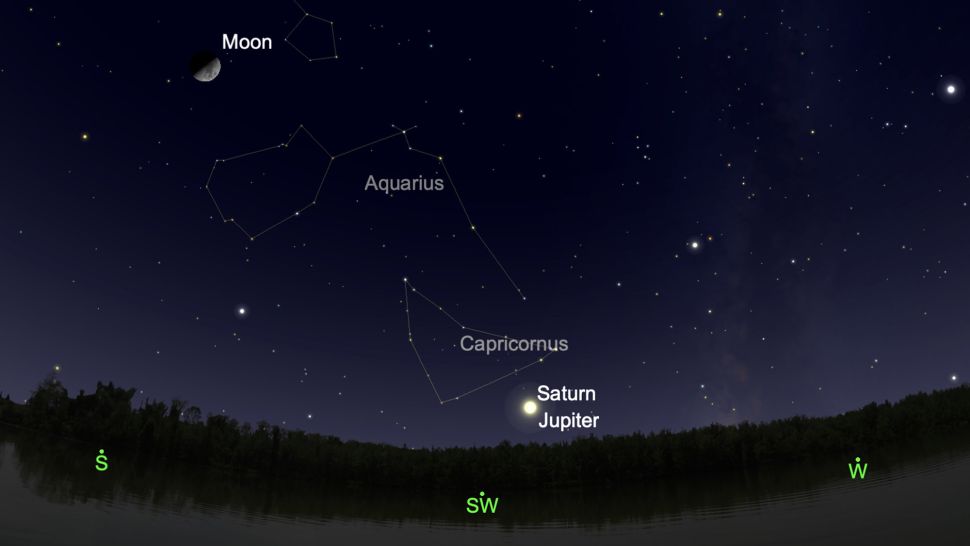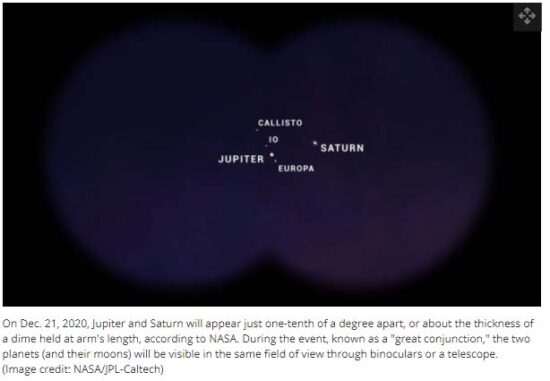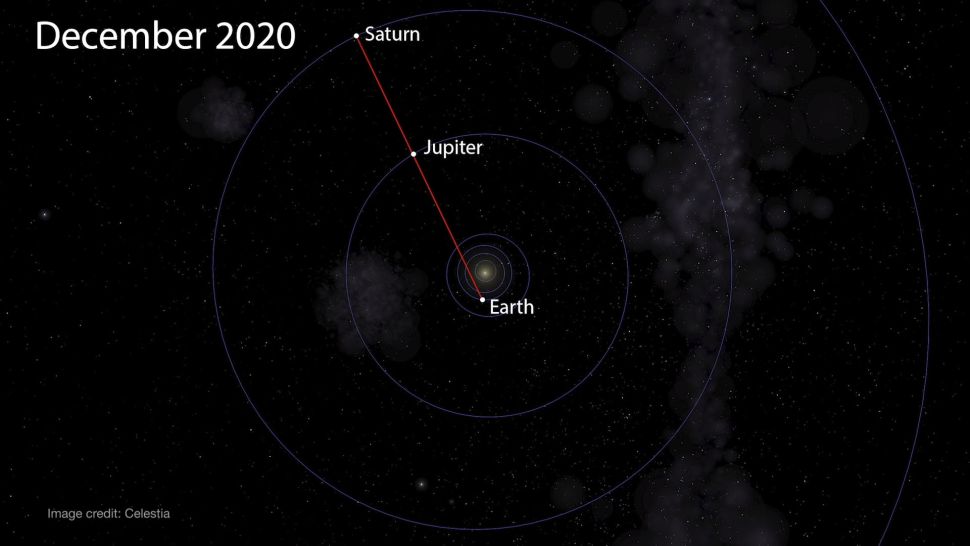‘Christmas star’ 2020: Here’s some fun facts about the ‘great conjunction’ of Jupiter and Saturn
We are now closing in on the long-awaited night of Dec. 21, when Jupiter and Saturn will engage in their “great conjunction.”
We call it a “great” conjunction because to ancient skywatchers, these were the two slowest moving planets in the sky. Jupiter takes nearly 12 years to describe a full circle in the heavens, spending a year visiting each zodiacal sign in the sky, while Saturn takes 29.5 years to make one full trip around the sun. Because of their respective slow movement, a conjunction or — to the ancients — a “celestial summit meeting,” was rather unusual. Such get-togethers happen, in most cases, about every 20 years on average.
So, when Jupiter and Saturn got together it was simply a conjunction, but a “great” conjunction!
‘Great conjunction’ 2020: NASA tips to see Jupiter and Saturn as a ‘Christmas Star’

Time and again
Usually when Jupiter and Saturn line up they are separated by about one degree, or twice the apparent diameter of the moon.
But on Dec. 21, we see Jupiter and Saturn separated by just 6 arc minutes. That’s equal to 0.1 degrees or about one-fifth the apparent width of the moon. Contrary to what other websites suggest, this will probably not be close enough to make the planets appear to merge into a single bright star (although some might see that if they remove their eye glasses). But in any case, it will be something exceedingly rare to see.
How often do these two planets come as close as that? Some websites say it has been nearly 400 years, while others say it’s been almost 800 years. Indeed, the last time these two planets appeared so close was on July 16, 1623, when they were only 5 arc minutes apart — that’s actually 397 years ago. There is a caveat however, for those living in temperate latitudes, such as New York, Paris or Tokyo, where the two planets were not visible because of their close proximity to the glare of the Sun and low altitude above the horizon.

This is not to say that the great conjunction of 1623 went completely unobserved. Visibility of this rare alignment would have only been visible from the tropics near the equatorial regions. If anybody living in northern South America, central Africa or Indonesia cared to look, they would have had a brief view of Jupiter and Saturn low in the west-northwest twilight sky on the evening of July 16th.
But the last time most of the world’s population had a favorable view of these two planets coming so close to each other was on March 5, 1226, when they were even closer together (just 2 arc minutes) compared to what we will see on Dec. 21.
I did a little research and used an orbital simulator to investigate all cases of when Jupiter and Saturn approached within 6 arc minutes of each other during the time frame from 1 A.D. to 3000 A.D. In the table below, column 1 gives the date, column 2 the minimum separation between the two planets, column 3 indicates whether the two planets were morning or evening objects and column 4 tells us if the planets could be observed — or too close to the sun or too low to be readily seen for most.
| Date | Separation | Time | Visible? |
|---|---|---|---|
| 372 March 6 | 2 arc min | morning | yes |
| 431 Dec. 31 | 6 arc min | evening | yes |
| 769 July 23 | 4 arc min | morning | no |
| 1226 March 5 | 5 arc min | morning | yes |
| 1623 July 16 | 5 arc min | evening | no |
| 2020 Dec. 21 | 6 arc min | evening | yes |
| 2080 March 15 | 6 arc min | morning | yes |
| 2417 Aug. 24 | 5 arc min | morning | yes |
| 2477 July 6 | 6 arc min | evening | yes |
| 2874 Dec. 25 | 2 arc min | evening | yes |
So, based on our list, these two planets come exceedingly close to each other on an average of once every 300 years. However, two on the list were visible only with great difficulty or not all. Factoring that in, we could say that the average goes up to 375 years.
But this is only an average.
Note that 794 years elapse between the conjunction of 1226 and 2020. Conversely, only 60 years separate the events of 2417 and 2477.
Star of wonder?
Some have suggested this holiday season that these two planets might be a replica of the legendary Star of Bethlehem. Actually, one of the more popular theories for the “Christmas Star” was a series of conjunction between Jupiter and Saturn in 7 BC. For in that year Jupiter and Saturn met not once but three times that year (in May, September and December).
The first conjunction (on May 29 — visible “in the east” before sunrise) presumably started the Magi on their way to Bethlehem from the Far East. The middle conjunction (September 30) may have strengthened their resolve in the purpose of their journey, while the third and final conjunction (Dec. 5) occurred just as they arrived in Judea to meet with King Herod, who sent them on to Bethlehem to “go and search diligently for the young child.”

But while single conjunctions of Jupiter and Saturn occur once every 20 years, such triple conjunctions are far less frequent, occurring about once every 180 years on average; the last time was in 1981, but the next won’t happen until 2239. For the Magi, Jupiter, pacing back-and-forth with Saturn in 7 BC would certainly have been looked upon as something unique.
But this year, Jupiter and Saturn will only have a single meeting, low in the southwest sky after sunset on Dec. 21. Whether from an astrological point of view that one single “celestial summit meeting” might have been a significant enough sign in the sky for the Magi to begin their trek to Judea is unknown.
But one thing is certain. If you consider a very close conjunction between Jupiter and Saturn as a “Christmas Star,” check out our table again and you’ll find our two planets will scrunch even closer together on Dec. 25, in the year 2874.
https://www.space.com/great-conjunction-jupiter-saturn-2020-fun-facts By: Joe Rao December 19, 2020
Comment: To quote Captain Kirk: Space the Final Frontier Or My Personal Choice: A New Beginning

See Also: Shooting Reindeer at the Old Folks Home